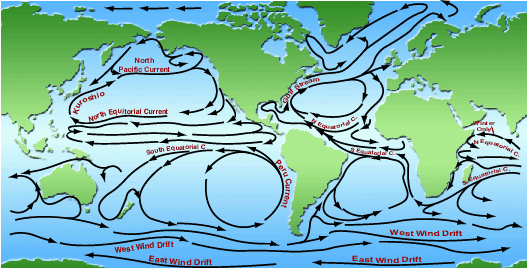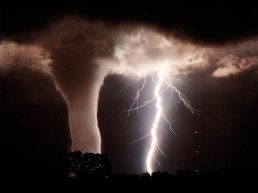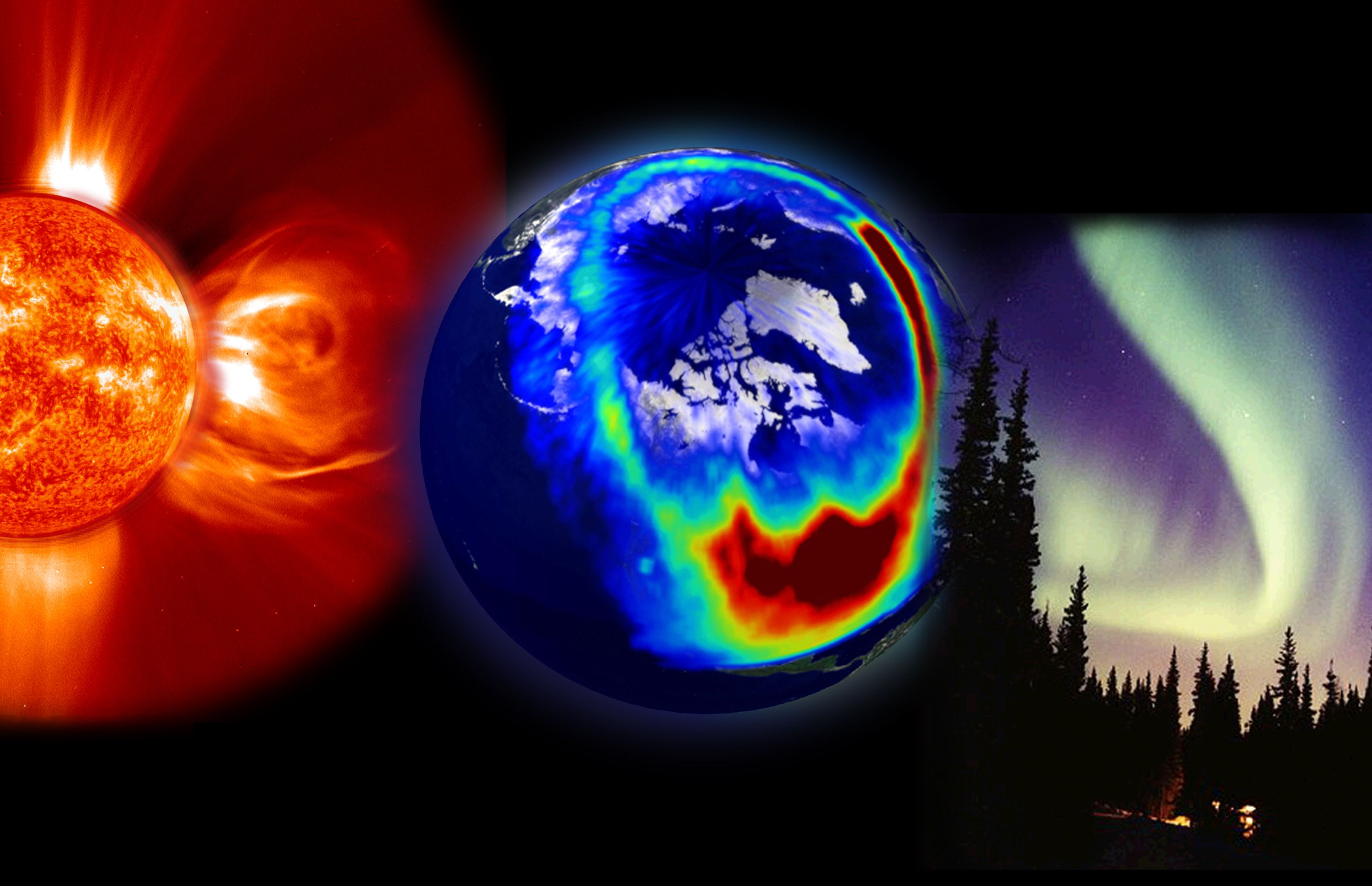Back when I was a college student looking for an easy way to meet my dreaded science requirements, I pounced on our college's Physical Geography course. It didn't have any yucky math. It would help me create fantasy worlds. Looked like it had a lot of geography in it. What I didn't realize when I signed on was that it also contained a bunch of the stuff I considered deadly dull: meterology and climatology being right up there with Subjects Assured to Put Me to Sleep.

And Jim Bennett wasn't going to let us off the hook. Noper. One of the first things he decided to teach was meterology. I nearly quit the class. Despite the fact Mr. Bennett had a great sense of humor - this is the man who, as our local TV station's weather forecaster, once whipped out half an umbrella because there was a 50% chance of rain that day - I thought I was in for the most boring week of my life.
By the end, I was wishing we'd do nothing but the weather.
Weather is one of the most complex phenomena in existence. So many factors impact it that it's a wonder we can predict it at all. The angle of incidence of the sun, the physical characteristics of the surface it's striking, temperature and moisture differences between regions
 , pressure differences, and even the weather itself all have an impact on the weather. This is ignoring the important factor of little things like mountains being in the way, or the axial tilt of the earth, or indeed its rotation... oh, and did I mention, the atmosphere's a chaotic system, so wee little changes in one bit lead to ginormous changes later on? Those damned butterflies and their wingflapping!
, pressure differences, and even the weather itself all have an impact on the weather. This is ignoring the important factor of little things like mountains being in the way, or the axial tilt of the earth, or indeed its rotation... oh, and did I mention, the atmosphere's a chaotic system, so wee little changes in one bit lead to ginormous changes later on? Those damned butterflies and their wingflapping!The thing is, though, it makes enough sense that even a rank amateur such as myself could look at the whispy little clouds in the sky on a bright, clear day and announce to my astonished friends that tomorrow it would rain - and be right. That's always fun.
(Mind you, that was Arizona, where such things as predicting rain can earn you respect. Here in Seattle, folks just tend to look at you and say, "Well, duh.")

Weather is huge, and weather is beautiful. Weather is interesting. Even the hydrologic cycle is fascinating. Who would have thought that something so simple as a little evaporation and condensation could cause such dramatic weather systems? I don't think a diagram can really capture the scope of it. Alas, we don't have Jim Bennett here doing his gymnastics - watching him go up on tiptoes waving his hands, swooping across the front of the classroom and imitating rain, was what made this bit so fun. Just use your imagination.
Our weather relies on oceans. Those great transporters of heat, cold and energy drive more weather than you can possibly imagine. I hadn't realized before studying phy
 sical geography that if you change the way the ocean circulates, you change the weather. El Nino, La Nina, and a bajillion other circulation changes large and small dictate what kind of weather we'll experience over a season. The way the currents move dictate whether you can grow palm trees in England, or shall be freezing your arse off in Labrador. Same latitude, wildly different climes. If we cut off the Gulf Stream, England would freeze.
sical geography that if you change the way the ocean circulates, you change the weather. El Nino, La Nina, and a bajillion other circulation changes large and small dictate what kind of weather we'll experience over a season. The way the currents move dictate whether you can grow palm trees in England, or shall be freezing your arse off in Labrador. Same latitude, wildly different climes. If we cut off the Gulf Stream, England would freeze.This is where plate tectonics has an interesting contribution to make to the weather. You see, when the continents move, they change the currents, which changes climate and weather, and that's damned interesting.
Let's move away from charts and get into some of the awesomeness, shall we?

Everybody loves a tornado. Not being in one, mind, but the power and thrill of seeing one from a safe distance. Get yourself some cold, dry air colliding with warm, moist air in a location where the winds can really get to whipping, and you've got yourself a strong possibility of touchdown. For a nice, succinct description of the science of tornadoes, start here. Or just watch a lot of courageous buggers on the Science Channel chase the storms - that's always instructive. It gives you a true sense of the power of weather when you see scientists dropping off equipment and then fleeing for dear life.
Tornadoes and wind have plenty in common. Wind starts when you've got a difference in air pressure - air flows from areas of high pressure to low. I once demonstrated this nicely for our physical geography class by having a photograph of myself taken at the blowhole
 at Wupatki National Monument - the air blasting out of the high pressure inside the cave to the lower pressure outside set my hair nicely a-whirl. On a larger scale, the Coriolis force from our rotating planet affects how the winds blow. There's all kinds of different winds, from the mildest breezes to the steady sea winds that caused these trees to grow at decidedly odd angles. Amazing what a little moving air can do, eh?
at Wupatki National Monument - the air blasting out of the high pressure inside the cave to the lower pressure outside set my hair nicely a-whirl. On a larger scale, the Coriolis force from our rotating planet affects how the winds blow. There's all kinds of different winds, from the mildest breezes to the steady sea winds that caused these trees to grow at decidedly odd angles. Amazing what a little moving air can do, eh?"White as the driven snow" is one of those hackneyed old phrases that's not scientifically accurate in t
 he least. Snow's actually clear, just like polar bear fur - it's the amount of light the flakes reflect that make it seem white. And Eskimos don't really have 100 words for snow, but science comes pretty close - skim down the list on Wikipedia, and you'll be surprised by how many varieties there are. In Arizona, we pretty much stuck with the vanilla varieties - powder on cold days, packing snow on the warmer. I know the skiers liked the powder variety, but you've got to have yourself a good packing snow in order to make truly complicated snow forts. Which we did, without ever realizing that our fun wouldn't have been possible were it not for the vagaries of elevation. Flagstaff, you see, is just at that elevation where the adiabatic temperature change coupled with a ginormous mountain forcing warm, moist air up where it could condense ensured we'd have plenty of winter wonderment.
he least. Snow's actually clear, just like polar bear fur - it's the amount of light the flakes reflect that make it seem white. And Eskimos don't really have 100 words for snow, but science comes pretty close - skim down the list on Wikipedia, and you'll be surprised by how many varieties there are. In Arizona, we pretty much stuck with the vanilla varieties - powder on cold days, packing snow on the warmer. I know the skiers liked the powder variety, but you've got to have yourself a good packing snow in order to make truly complicated snow forts. Which we did, without ever realizing that our fun wouldn't have been possible were it not for the vagaries of elevation. Flagstaff, you see, is just at that elevation where the adiabatic temperature change coupled with a ginormous mountain forcing warm, moist air up where it could condense ensured we'd have plenty of winter wonderment.What, you're shocked Arizona gets snow? You need to get out more. Arizona's got everything. We even got a hurricane once. And in a few million years, we'll have a coastline, too.
Another thing we have is the world's most incredible lightning. Scientists, photographers and siteseers flock to Tucson, where the lightning strikes light up the universe. The storms there are truly incredible. The science of lightning, hundreds of years after Ben Franklin and his infamous kite, still isn't complete, but there are some good theories as to how the whole production gets started. The polarization mechanism hypothesis is pretty sexy - it has two components, and a key, thusly:

- Falling droplets of ice and rain become electrically polarized as they fall through the atmosphere's natural electric field;
- Colliding ice particles become charged by electrostatic induction.
Ice and supercooled water are the keys to the process. Violent winds buffet tiny hailstones as they form, causing them to collide. When the hailstones hit ice crystals, some negative ions transfer from one particle to another. The smaller particles lose negative ions and become positive and the larger more massive particles gain negative ions and become negative.
Sounds about right to this Arizona girl, who knows that those enormous thunderheads contain plenty of ice crystals, hail and wind. Whatever its beginnings, its end result is truly spectacular - how many other things in this world can heat the air to twice the temperature of the Sun? And leave fossil trails in the form of fused silica?
After all that, it might be nice to immerse ourselves in a calm, soothing rain. If you haven't got any where you are, feel free to join me in Seattle, where light, misty rains are our specialty. But don't expect teardrop shapes - you're getting spheres, hamburger buns, or parachutes, depending on the size of the drop. And you can expect more rain on Saturday in areas with a lot of pollution building up during the week. Plan accordingly.
One of the most interest ing aspects of weather and climate in the rain department is the rainshadow effect. You get a spectacular example of that here in Washington, where the Cascades force the clouds to climb. That warm, moist air condenses and cools on its way up, dumps most of its payload on the western flanks of the range, and leaves eastern Washington a lot drier.
ing aspects of weather and climate in the rain department is the rainshadow effect. You get a spectacular example of that here in Washington, where the Cascades force the clouds to climb. That warm, moist air condenses and cools on its way up, dumps most of its payload on the western flanks of the range, and leaves eastern Washington a lot drier.
In Arizona, rain followed a monsoon pattern. And yes, we do get rain there, every summer regularly. The thing is, it usually evaporates so fast you barely know it was there. You might not be able to photograph dragonflies with rain on.
Convinced of the beauty of the weather? Want more? Good. Cuz I've got animations for ye courtesy of Edupedia, and NOAA's wonderful weather site complete with tutorials. And if that's still not enough, remember: there's a whole solar system full of weather out there. Amazingly enough, you'll find that, just like with weather patterns in Asia having an effect half a world away, what happens 98,000,000 miles away has some pretty spectacular local impacts.
Incredible, ne c'est pas? And here you thought weather was boring.









2 comments:
Everybody loves a tornado.
On April 3, 1974, I watched the sky turn green -- green! -- just before Dad hustled us into the crawlspace. Found out about the death and destruction the next day.
I do not love tornados at any distance.
Distance changes perception, doesn't it, Howard? I graduated from high school that year in eastern Pennsylvania, but I don't remember that event at all.
Anyway, love the link on chaos, Dana. I'm going to get back to and absorb the rest later. I just finished writing about how we failed to learn from science in our policy toward Afghanistan, and for now play time is over.
Post a Comment